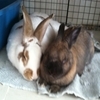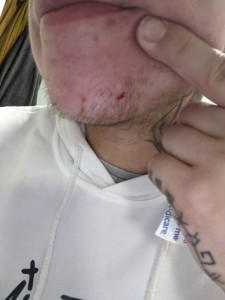House Rabbit Community and Store
-
Sign In
- Sign In
-
 Forum
Forum
-
 Store
Store
- This Forum and Store have separate secure Sign Ins
OUR FORUM IS UP BUT WE ARE STILL IN THE MIDDLE OF UPDATING AND FIXING THINGS. SOME THINGS WILL LOOK WEIRD AND/OR NOT BE CORRECT. YOUR PATIENCE IS APPRECIATED. We are not fully ready to answer questions in a timely manner as we are not officially open, but we will do our best.
You may have received a 2-factor authentication (2FA) email from us on 4/21/2020. That was from us, but was premature as the login was not working at that time.
BUNNY 911 – If your rabbit hasn’t eaten or pooped in 12-24 hours, call a vet immediately! Don’t have a vet? Check out VET RESOURCES
The subject of intentional breeding or meat rabbits is prohibited. The answers provided on this board are for general guideline purposes only. The information is not intended to diagnose or treat your pet. It is your responsibility to assess the information being given and seek professional advice/second opinion from your veterinarian and/or qualified behaviorist.
What are we about? Please read about our Forum Culture and check out the Rules.
The subject of intentional breeding or meat rabbits is prohibited. The answers provided on this board are for general guideline purposes only. The information is not intended to diagnose or treat your pet. It is your responsibility to assess the information being given and seek professional advice/second opinion from your veterinarian and/or qualified behaviorist.
- This topic has 8sd replies, 4 voices, and was last updated 3 years, 7 months ago by
 DanaNM.
DanaNM.
-
AuthorMessages
-
-
03/09/2022 at 11:37 AM
I have a 10-week old male who is absolutely the sweetest thing apart from the past week he has taken to biting the end of my nose and my chin he also tries to bite my lip.
The thing I don’t understand is if I just picked him up and he bit me, I could understand that however he is always licking me lovingly beforehand and I don’t get a gentle nip as you can see in the picture it has drawn blood.
He previously add full training for house but this appear to make him more aggressive so I recently limited him to just the living room which did improve things for a few days today I’ve been in meetings for most of the day so I thought he was just enthusiastically licking me to greet me. Unfortunately not.
Scolded him by putting him down and misting his bum, however this seems to do absolutely nothing. As does running my finger down his nose to show I am in charge.
I’m back in his cage for now because I genuinely can’t think of another way to scold him.
I yelped when he did it to let him know he hurt me but he didn’t seem remotely bothered then tried to go on to lick then my lip. He was more shocked by the pitch change than anything.
I have been in meetings all day today so I didn’t know if maybe that was why he nipped me.
He went straight into his matted straw pulling mat as soon as he was in the cage and headbutted his log around.
Is he just hormonal? If so do I just ignore this? Because he wanted attention initially and so I picked him up.
Any advice is welcome. I’ve cleaned up my chin but this was it before, so not a huge huge bite but it drew blood so that was the final straw.
[caption id="attachment_1959784" align="alignnone" width="225"]
 Bleeding bite mark on my chin[/caption]
Bleeding bite mark on my chin[/caption] -
03/09/2022 at 12:29 PM
The idea of trying to assert dominance over a rabbit via holding their head down or similar methods, to me personally, makes no sense and I have not heard of cases where it is reliably effective. If anything, it simply creates a negative association and the rabbit distances themselves from the owner, therefore eliminating whatever problematic behavior there is, but that is the result of distancing/fear, rather than successful dominance assertion. It is likely 100% apparent to rabbits that humans are very large predators. They do not readily incorporate us into their social hierarchy like other rabbits so I do not find behavior modifications rooted in dominance logic as an effective framework.
Some things to keep in mind are 1) how novel the idea of bare skin, lips, and a human face in general is to a rabbit, 2) that rabbits cannot directly communicate with humans (and other rabbits really; they don’t talk obviously, haha) and licking and nipping are literally some of the only ways to try and get a response, and 3) human bodies are huge and confusing for rabbits so the recognition that xxxx extremity is you, is capable of feeling pain, etc., may be a bit of a learning curve for a rabbit. Sure, you smell like you, but so does your clothes, your couch, etc… and those aren’t things that are giving pain feedback when your rabbit digs or chews at them.
Rather than restricting space or trying dominance-logic feedback, I think more time spent passively in his presence to increase learning opportunities for both of you is needed. You just got him (I assume since he’s 10wo), and he’s a growing, learning rabbit who fundamentally is not going to understand humans. It’s going to take a while for you to learn how to decode what he is trying to communicate with you and for him to learn what are the most effective ways to communicate with him. For example, nips can mean many things. For young rabbits especially, it can be curiosity about a thing. It can be a request for the object to move out of the way, it can be a request for attention of a different kind (ex. if your rabbit hasn’t had any socialization/interaction since you’ve been in meetings all day, he might be searching for a way to engage pent-up chewing energy that a rabbit naturally has), it can be a request for food…. many different interpretations. Notably, a rabbit wanting attention typically never means they want to be picked up — rabbits, by default, do not like being picked up and would rather be cuddled/pet on the ground.
In terms of what to do to promote learning on your rabbit’s end, I recommend redirection/guidance. For my Fable, who came to me as a very nippy, 1yo rabbit with very effective nips (her nips drew blood by default, which is not great…), I would use the back of my hand (as opposed to the palm side, where skin is more sensitive) and gently push her face away from me from me. I would repeat this every time she nip me, even if it meant doing it 5 times in a row. Paired with learning more about her personality, ways of communicating, body language, and being more effective in making the environment engaging for her to expend energy, she has successfully learned to just nose boop me continuously to communicate, rather than nip.
This may be a helpful resource to read through: https://wabbitwiki.com/wiki/Behavior_FAQ#My_bunny_never_wants_to_come_to_me._I_can_never_pet_them._What_can_I_do?
… in addition to this: https://wabbitwiki.com/wiki/Understanding_your_rabbit
…. and also, yes, being a young rabbit is going to make things more tricky. Arguably at 10wo your rabbit may not even be hormonal yet, so there’s a chance that territorial aggression will see to it that your rabbit gets more actively lungey/aggressive upon your attempts to encroach on his space or pick him up. It is not a choice to make you upset or angry, but a reaction to protect itself as your rabbit cannot read your mind and know your intentions.
The answers provided in this discussion are for general guideline purposes only. The information is not intended to diagnose or treat your pet. Seek the advice of your veterinarian or a qualified behaviorist.
-
03/09/2022 at 12:45 PM
Appreciate your response, I also felt the same way when reading about holding their head down and similar methods, but was willing to give it a go.
I’ve had rabbits before and they’ve not been like this at all so was a little surprised he was so nippy so quickly.
I’ve had him coming up for three weeks now, I picked him up at 8 weeks old and he’s coming up to 11 weeks (I realised after posting)
Make really good points about not being able to recognise the difference between me and the sofa although he doesn’t tend to nip at the sofa or scrapped at the sofa at all, occasionally will nip the back of my trouser legs for attention that’s about as far as it goes I will try your suggestion of pushing his head gently away from me when he doesn’t next time and see how I get on that way because honestly timeout feels like he’s going to spend more time in his crate.
Just given it a go and now he’s sulking in the corner, he even went behind me to try and get me from behind little bugger! Will see how we go forward.
-
03/09/2022 at 1:21 PM
I don’t find the time-out to work/make sense either — I don’t think many rabbits are going consistently and reliably make the several associations needed for that training tactic to work. Intuitively, I think it asks rabbits to understand the following: 1) nipping = bad, 2) put in cage = because you nipped me, 3) being put in cage = punishment for nipping, 4) time spent in cage = punishment for nipping … that’s a lot to ask for a tiny bun brain. I think tiring out his young-bun energy may be a better way to calm him down, and that would involve engagement with you/toys rather than confining him.
Also, unsure how large the “cage” is, but generally no habitat advertised as a cage is appropriately sized for a rabbit. You can see our housing section for details: https://binkybunny.com/infocategory/house-rabbit-habitats/
The answers provided in this discussion are for general guideline purposes only. The information is not intended to diagnose or treat your pet. Seek the advice of your veterinarian or a qualified behaviorist.
-
03/09/2022 at 5:42 PM
You can use timeouts with rabbits, but not in the way most people would think. Using a timeout as a punishment doesn’t work because, as Wick said, they don’t really understand that they are being punished for X behavior. Instead, a timeout can be used as a tool to break a cycle. For example, bunny is obsessively doing something they shouldn’t and they just won’t leave it alone. You try to redirect and they just go right back to it. Completely removing them from the area (either by blocking it off or putting them in an enclosure) for a little while can help them “forget” about what they were desperately wanting to do. At least for awhile, anyway. I had very good luck with this when it came to carpet chewing.
To be honest, the nipping behavior you are describing doesn’t sound unusual. Young bunnies tend to explore things by nipping and some are just more aggressive with the nipping than others. Bunnies also nip in order to get attention… usually because they want something (food, treats, etc.). They can also nip when they want you to move or they are displeased with something you’re doing (brushing, etc.). It all depends on the context, I suppose.
Have you tried squealing when he nips you? Squealing like a rabbit in pain tells him that he is hurting you. A lot of bunnies seem to respond to this.
Random thought – What kind of rabbit is he? Is he a lop? I have a deaf Holland and he tends to nip more because he doesn’t know how else to communicate.
-
03/10/2022 at 4:09 AM
He’s only ever in his cage when I have to go out, I work from home so probably an hour or two tops a day and it’s a good 3x4m at the moment and I plan on extending it once he’s bigger.
Hes got so many toys, chews, bells, pulling mats and boxes to choose from. We have an electric water bowl as well so the water is running and not still as he seemed to prefer running water (there aren’t cables).
I tried “Squealing like a rabbit” but as a bloke the squealing bit doesn’t really happen and he just looked at me like I was a f’ing idiot to be honest and then tried again after another few licks.
I am giving him the best I can give, without y’know blowing my entire budget which is now a bit tight given energy bills and I am a single parent.
He’s a mini-lop.
He’ll be so so so gentle and caring and you’d never know it’d come and then all of a sudden it’s BAM teeth!
He also constantly tries to pull at my trousers, so I’ll pick him up and fuss him, although this is usually when I am doing the washing up, then put him down and he’ll either go on his merry way or continue to bite my trousers/hoodie.
Toast is definitely not deaf, he heard the washing machine beep for when that’s done.
Having just watched him jump in my laundry box, I was worried he was going to eat the clothes but he seemed to almost groom the clothes.
Could he be just overly grooming and his nips are just…a bit over eager?
-
-
03/09/2022 at 7:04 PM
I was also going to suggest the squealing tip! Kind of like a high-pitched “EEEEK”. Buns nip each other through fur so it doesn’t really hurt, so they may not realize they are hurting us when they nip.
. . . The answers provided in this discussion are for general guideline purposes only. The information is not intended to diagnose or treat your pet. Seek the advice of your veterinarian or a qualified behaviorist.
-
03/10/2022 at 4:21 AM
Heya thanks for the reply, as I posted above just now, the high pitched squeals I did try once. No luck. Probably because I am a bloke and incapable of a high-pitched note.
-
-
03/10/2022 at 8:48 AM
If the squealing doesn’t work (it doesn’t always work with my Cooper either), then redirecting is the best option. One thing with bunnies is that if you move around in front of their face or under their nose, it can trigger biting. And a hand on the head can be seen as grooming, so could be interpretted by the bun as a reward. So I usually use a gentle but firm hand over the bun’s shoulders to redirect them away from whatever they are biting.
He’s so young, I almost interpret this as “teething” behavior. He’s still exploring the world, which rabbits unfortunately do with their teeth. Best practice may be to remove the opportunities for biting as much as possible.
. . . The answers provided in this discussion are for general guideline purposes only. The information is not intended to diagnose or treat your pet. Seek the advice of your veterinarian or a qualified behaviorist.
-
-
AuthorMessages
- You must be logged in to reply to this topic.
